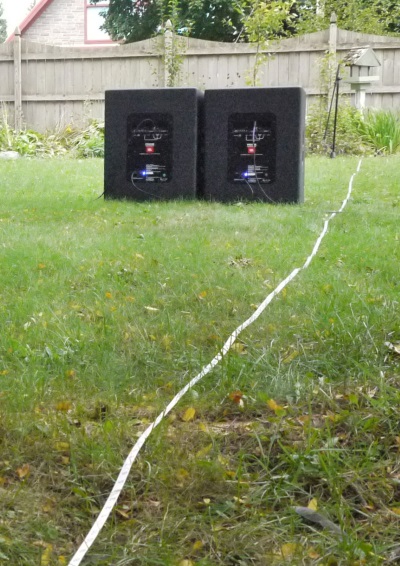
In the back of the array, it’s a different story indeed: the output from the rear box arrives first, and the output from the front box is quite late – it’s physically farther away, and it’s electronically delayed. The physical 4’/4” of propagation delay (3.8 ms) adds to the electronic delay (also 3.8 ms) to create a cumulative time offset of 7.6 ms at the rear.
This is where realize the importance of the spacing we chose earlier: 7.6 ms is half a cycle at 65 Hz, meaning the output from the two subs is separated by 180 degrees at this frequency, causing a cancellation. That time offset corresponds to a different phase offset for other frequencies, and since 180 degrees is our “best case scenario” for a deep cancellation, the quality of the rear rejection rapidly decreases above and below 65 Hz.
Figure 5 shows the rear response (red), as well as how the output in front (black trace) compares to our Gold Standard of the full +6 dB that we’d get from a standard broadside arrangement.

We’ve created a nice bit of rear rejection centered in the 65 Hz region, and… not much else. Outside of that 65 Hz dip, we might as well be standing in front of the array. From our mic position 20 feet out in front, efficiency is within a few dB of Gold and will get even better as we move deeper into the audience area.
We also have a pretty clean output, with only a single, in-polarity arrival out front, so this array configuration has minimal sonic degradation. Unfortunately, there’s little gained in terms of rear rejection, either.
Constructing a larger, four-element endfire array based on the same principle provides more scattered arrivals in the rear and can achieve excellent broadband rear rejection – if you have the subs and the space!
Inline Gradient Array, Inverted
The problem with relying on phase offset to achieve rear cancellation is that it doesn’t hold over frequency. This time, we’ll use polarity, which is frequency-agnostic, to build a rear cancellation that holds throughout the entire frequency range.
The physical configuration is identical to the previous array, however this time it’s rear box, rather than the front, that’s delayed. This array is tuned from the rear – while viewing the response from the rear mic, the upstage box is delayed until its arrival matches that of the front box.
At this point it’s the same array we just explored above, only firing the other way. Then the upstage box is polarity-inverted, turning a rearward summation into a rearward cancellation. The rear-going wave from the front sub is well-cancelled by that of the rear sub. (This is exactly how noise-cancelling headphones work, by the way.)
Figure 6 shows the proper situation in the rear, with the two phase traces 180 degrees apart at all frequencies, indicating an out-of-polarity state.

Figure 7 shows the respectable broadband rear rejection achieved as well as the comparison to Gold in the forward direction. Remember that the rear cancellation will improve with distance.

